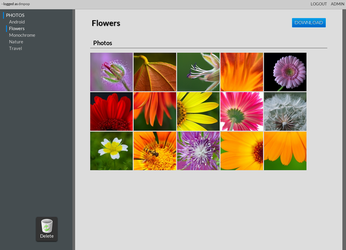Publish Photos with PhotoShow

Productivity Sauce
Hosting your own photo sharing solution makes a lot of sense, but setting up and maintaining a full-blown application like Gallery or Piwigo requires some technical chops and can be a time-consuming affair. Enter PhotoShow, an open-source photo sharing software that can be deployed in a matter of minutes and requires practically no maintenance.
Unlike many other photo sharing applications, PhotoShow doesn't use a database back end, which dramatically simplifies the installation procedure. In fact, there is no installation procedure to speak of. Grab the latest release of PhotoShow from the project's website GitHub repository, unpack the downloaded archive, and rename the resulting directory (e.g., photoshow). Open the /photoshow/config.php file in a text editor and specify two parameters: $config->photos_dir (the directory containing your photos) and $config->ps_generated (directory for storing contents generated by the application). Move the entire photoshow directory to your server, and point your browser to http://127.0.0.1/photoshow. When prompted, specify a user name and password for the administrative account, and you're done. To configure the application's settings, log in using the specified credentials, and switch to the Admin section. Here, you can specify a gallery title, disable registration and the ability to download photos and entire albums as well as enable Facebook and Google+ buttons. PhotoShow supports comments, but the application doesn't provide any anti-spam functionality. So you might want to disable the commenting feature altogether. In the Admin section, you can also add users and groups and organize them into groups. Later, you can make any photo private and grant access to it to specific users and groups.
Populating PhotoShow with photos is as easy as dropping them onto the upload area in the right sidebar. While PhotoShow doesn't support tags, it allows you to organize your photos into albums and sub-albums. You can create as many albums as you need using the appropriate button in the right sidebar. Another way to add photos to your PhotoShow instance is to simply copy them directly to the directory path which is specified in the /photoshow/config.php file. This means that you can upload photos (and create folders, i.e., albums) from any machine and device as long as the target directory is accessible via FTP, SSH or other protocols. For example, using apps like FolderSync, you can upload photos from an Android device directly to your PhotoShow installation, provided you can connect to the server via FTP.
A quick tip: before you add photos to PhotoShow, it's a good idea to resize them to speed up the gallery. You can use the convert tool, which is part of the ImageMagick package, to do this. The following command processes all JPG images in the current directory, reducing their size by 50% and setting their quality to 91%:
for i in *.jpg; do echo "$i"; convert "$i" -resize 50% -quality 91% "$i"; done
While PhotoShow lacks all the bells and whistles of more advanced photo sharing applications, this tool is perfect for hosting a no-frills photo gallery on your own server with a minimum of effort.
comments powered by DisqusSubscribe to our Linux Newsletters
Find Linux and Open Source Jobs
Subscribe to our ADMIN Newsletters
Support Our Work
Linux Magazine content is made possible with support from readers like you. Please consider contributing when you’ve found an article to be beneficial.

News
-
TrueNAS 25.04 Arrives with Thousands of Changes
One of the most popular Linux-based NAS solutions has rolled out the latest edition, based on Ubuntu 25.04.
-
Fedora 42 Available with Two New Spins
The latest release from the Fedora Project includes the usual updates, a new kernel, an official KDE Plasma spin, and a new System76 spin.
-
So Long, ArcoLinux
The ArcoLinux distribution is the latest Linux distribution to shut down.
-
What Open Source Pros Look for in a Job Role
Learn what professionals in technical and non-technical roles say is most important when seeking a new position.
-
Asahi Linux Runs into Issues with M4 Support
Due to Apple Silicon changes, the Asahi Linux project is at odds with adding support for the M4 chips.
-
Plasma 6.3.4 Now Available
Although not a major release, Plasma 6.3.4 does fix some bugs and offer a subtle change for the Plasma sidebar.
-
Linux Kernel 6.15 First Release Candidate Now Available
Linux Torvalds has announced that the release candidate for the final release of the Linux 6.15 series is now available.
-
Akamai Will Host kernel.org
The organization dedicated to cloud-based solutions has agreed to host kernel.org to deliver long-term stability for the development team.
-
Linux Kernel 6.14 Released
The latest Linux kernel has arrived with extra Rust support and more.
-
EndeavorOS Mercury Neo Available
A new release from the EndeavorOS team ships with Plasma 6.3 and other goodies.

